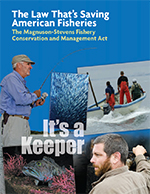A New Approach to Protect Our Oceans
As a young Coast Guardsman in the 1970s, I saw the problems we faced enforcing our nation's fishing laws. Too many large foreign fishing trawlers, using devastatingly efficient technology, caught massive amounts of our fish. Today, those ships are gone, and we are on track to end the problem of overfishing in U.S. waters. In fact, we now have one of the most advanced marine resource management programs in the world.
These changes wouldn't have been possible without the 1976 passage of the Magnuson-Stevens Act, the bedrock of modern U.S. fisheries management law. Updates in 1996 and 2006 gave the law a greater conservation focus, requiring federal managers to rebuild depleted fish populations and set strong, science-based catch limits that prevent overfishing. This made a huge difference. Over the past 11 years, rebuilding plans have restored 32 severely depleted fisheries, including Pacific lingcod and mid-Atlantic bluefish.
The Magnuson-Stevens Act is due for another update. Though American coastal communities are starting to see a return on decades of hard work, the oceans face renewed pressure from a host of threats. Indiscriminate fishing practices continue to damage irreplaceable marine habitat, kill too many species incidental to the targeted catch, and remove too many of the small forage fish that provide food for many of the larger inhabitants of the ocean. Together with warming temperatures and more acidic waters, these ecosystem-wide burdens stand to undermine previous accomplishments.
We now know that saving our nation's fisheries one species at a time is an inefficient way of doing things. For many individual types of fish, current policies help stem the severe damage to them from overfishing. But the overall health of the oceans continues to deteriorate. Enormous trawlers can drag equipment across the ocean floor, scraping it almost bare and destroying places where marine organisms live. Other vessels deploy longlines that stretch an average of 30 miles, baited with hundreds of hooks, which catch and kill severely depleted bluefin tuna. They also haul in approximately 80 species of ocean wildlife, with most thrown back dead or dying. And the catch of small schooling fish such as Atlantic menhaden and Pacific sardines take away potential food from ocean predators, among them salmon, seabirds, and whales.
As far back as 1996, Congress and NOAA recognized that fisheries need to be managed to protect the ecosystems upon which they depend in the long run, yet ending overfishing has been the first priority. We've made great strides on this front. But Congress and fisheries managers now need to tackle the other issues identified nearly two decades ago by the Magnuson-Stevens Act, but not emphasized as priorities at the time, such as reducing bycatch, protecting habitat, and managing fish as a part of a larger ecosystem, not species by species. Doing so would help safeguard our gains and allow us to grapple with new threats to our oceans.
When the National Oceanic and Atmospheric Administration hosts its upcoming Washington summit May 7-9 on the future of U.S. fisheries, it will mark the first step in the effort to again reauthorize the Magnuson-Stevens Act. This meeting of stakeholders at Managing Our Nation's Fisheries III should jumpstart congressional debate by requesting stronger legal authority to protect key habitat areas, requiring forward-thinking plans to maintain healthy ocean ecosystems, and safeguarding the small fish that help sustain life in the ocean.
Many things have changed on the water since my days on the Coast Guard cutter Vigilant in the mid-1970s. But the importance of healthy fish populations as a source of commerce, sustenance, and recreation to U.S. coastal communities has not diminished. Nor has the need for underlying, intelligent policies. Public cynicism about the effectiveness of government may be near historic highs, but when partisanship is put aside, as we've seen with the enactment and previous reauthorizations of the Magnuson-Stevens Act, the results can be remarkable.
The provisions of the law that brought us to the verge of ending overfishing are just the first step toward sustainable fisheries management. Congress therefore has a unique opportunity to build on past marine policy success and move toward a more thorough ecosystem approach that will prove vital in addressing current and rapidly evolving challenges in the decades to come.












